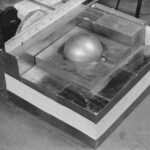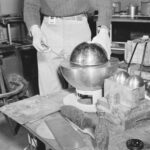Before Windscale, Three Mile Island, Chernobyl, and Fukushima, there was the Demon Core.
The Demon Core was a 6.2-kilogram subcritical mass of plutonium, which briefly went critical in two separate accidents at Los Alamos National Lab in 1945 and 1946. Each incident resulted in acute radiation poisoning and the subsequent death of a scientist. After the incidents, the spherical plutonium pit was dubbed the Demon Core.
On 21 August 1945, the plutonium core produced a burst of radiation that led to death of physicist Harry Daghlian. Daghlian was working alone, performing neutron reflection experiments on the core. The core was placed within a stack of neutron-reflective tungsten carbide bricks, and the addition each brick pushed the core closer to going critical. Daghlian was attempting to stack another brick on the pile when he dropped it on the core by accident. Despite his quick action to pull the brick off the assembly, Daghlian received a fatal dose of radiation and died 25 days later.
On 21 May 1946, physicist Louis Slotin and several others were conducting an experiment to verify the exact point at which a subcritical mass could be made critical by positioning neutron reflectors. It required the operator to place two half-spheres of beryllium, a neutron reflector, around the core to be tested and manually lower the top reflector over the core. Scintillation counters measured the relative activity from the core as the reflectors were moved closer and farther away from each other. The blade of a standard flathead screwdriver was necessary to keep the reflectors from closing completely around the core because it could result in instantaneous formation of a critical mass and a lethal power excursion. While lowering the top sphere, Slotin’s screwdriver slipped outward a fraction of an inch, and that was all that was needed for the top reflector to fall into place around the core. Instantly there was a flash of bright blue light and a wave of heat passed over Slotin’s skin; the mass had become supercritical, releasing a massive burst of neutron radiation. Slotin quickly knocked the two halves apart, stopping the chain reaction and saving the lives of his colleagues. He received a lethal dose of radiation and died 9 days later.

